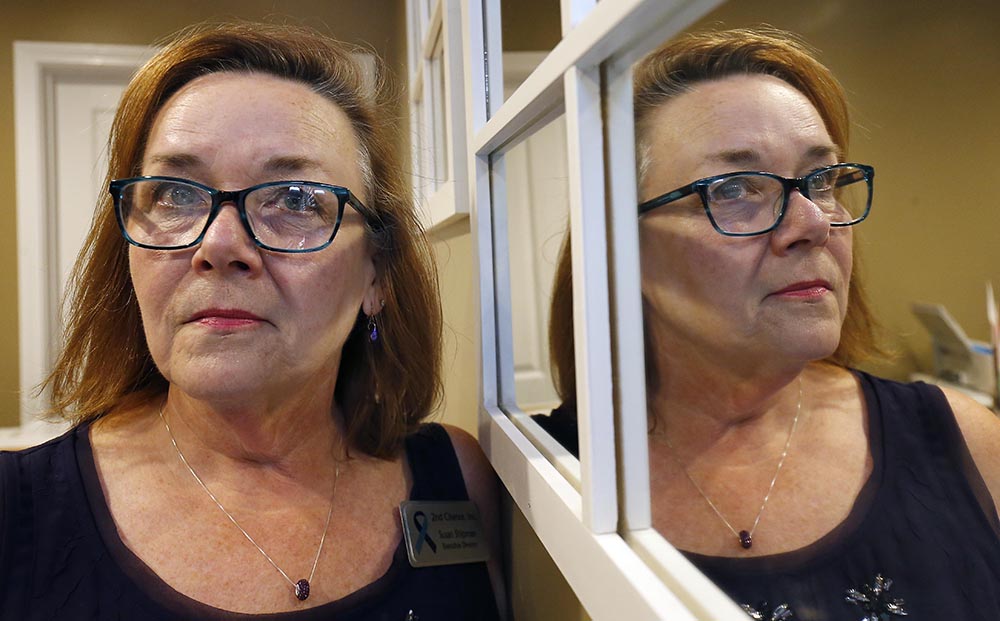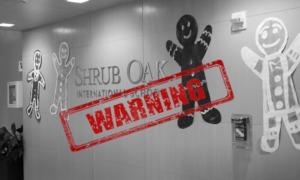
Stephen Gross/The Anniston Star
Intimate partner violence is both Susan Shipman’s job and deeply personal. She is the executive director of 2nd Chance Inc. in Anniston, Ala.
ANNISTON, Ala. — When Susan Shipman took a job as a bookkeeper at a women’s shelter in Anniston in 2003, she didn’t realize how close to her own home violence already was.
“I signed up for a flexible, part-time job,” Shipman, 57, said. “And I found myself in the movement to end violence against women.”
By 2006, Shipman was the executive director of 2nd Chance Inc., a nonprofit safety and support organization for victims of domestic and sexual violence serving nearly 500 women and children annually in North Alabama.
Today, Shipman’s knowledge of intimate partner violence is both encyclopedic and deeply personal. “I had some not great partners. I’m an educated, intelligent woman, so that hasn’t got anything to do with how we find ourselves in these situations,” she said.
The Centers for Disease Control and Prevention reports 1 in 4 women and 1 in 10 men experience violence — physical, sexual and/or psychological — and stalking by a current or former partner. The public health toll for victims is staggering: physical injuries, mental health consequences and greater risks for chronic conditions of the heart, digestive, reproductive and nervous systems. The public financial toll is estimated at $3.6 trillion for “lifetime economic costs” for health care, lost productivity and criminal justice services.
“People do not understand what it’s like,” said Christina Thomson, a 53-year-old who said she survived a night of torture on April 6, 2016, at the hands of an ex-boyfriend. Jeffery Simmons beat and raped Thomson for six hours, she said, threatening to shoot her and bury her in the woods behind his home in Etowah County if she tried to flee. “My life was turned upside down. I had to go into hiding for three years [during delayed court proceedings]. I lost two jobs. I don’t like to go out at night. I’m looking over my shoulder constantly.”
Public health experts say intimate partner violence is a national public health crisis. And the ultimate cost is the loss of life.
“My sister-in-law was murdered on Aug. 29 of 2017 by her ex-husband,” Shipman said. After years of abuse, Larry Miller shot and killed Judy Miller in their Jacksonville, Ala., home.
Firearms are the single greatest predictor of homicide in a domestic violence situation but little is done to truly keep guns out of the hands of known abusers.
In Alabama, state law is the same as federal law, forbidding known abusers or individuals convicted of a misdemeanor domestic violence crime from owning a firearm if there’s a recorded protection from abuse order. But federal and state law fail to require firearm relinquishment, meaning dangerous individuals often keep their guns.
Shipman’s brother-in-law “had access to firearms,” she said. “And he shouldn’t have.”
Victims often don’t report violence
For years, Larry Miller terrorized his family with threats of violence.
“My sister-in-law did the things we suggest a victim do,” Shipman said. “She fled. She went to a shelter not in this town.” None of those efforts saved her life.
When Judy first left, Shipman said the police knew the home was unstable and Larry Miller was dangerous and armed. He was on probation for a firearms charge. Shipman helped her sister-in-law file a protection from abuse order.
The morning she died, police were enroute to the home after receiving a 911 call from Judy Miller. But they arrived too late, finding Larry with a firearm in each hand, threatening officers. Unable to disarm him, police shot and killed the man who’d killed his ex-wife moments before.
In Alabama the year Judy Miller died, there were 4,291 domestic violence reports, according to the latest data from the Alabama Law Enforcement Agency. Although only 4% of domestic violence instances involved a firearm, those were the most deadly domestic abuse encounters; more than 70% of Alabama intimate partner homicides were by firearm.
The Department of Justice reports 1 in 6 people killed in the U.S. are murdered by an intimate partner and more than half of female homicide victims are killed by a current or former partner. National trends align with Alabama, as 70% of victims of intimate partner violence are killed with firearms.
All people are at greater risk when a firearm is in a home, but the CDC reports young women of color are disproportionately harmed and killed.
Shipman said it’s important to remember victims often don’t report violence because they don’t always trust police or because past reports haven’t led to change. So the collective understanding of how widespread this public health epidemic is is complicated. States with more centralized reporting systems than Alabama’s department of health have better data.
[Related: Taking Firearms From Domestic Violence Suspects Is Challenging, Officials Say]
“States have traditionally approached domestic violence as a social issue first and a health issue second,” said Stuart H. Hoyle, epidemiologist and data manager for the Alabama Department of Public Health. ADPH does not track domestic violence, relying on partner agency data. Other states are “more centralized … with all state data in one system,” Hoyle said.
The result leads to a misunderstanding of how domestic violence isn’t just a problem at home, Shipman said.
When known abusers have access to firearms, the threat not only affects the vulnerable families of abusers, but the public at large, including friends, co-workers and law enforcement officers like those who arrived when Judy Miller called 911 fearing for her life. Despite the emphasis on mental illness and mass shootings, public health experts suggest there is a closer link between mass shooters and domestic violence, as more than half of mass shootings in the U.S. have involved the shooter first killing a loved one.
“It’s a complicated and widespread issue,” said Allison Dearing, the executive director of One Place Metro, a service organization partnership between the Jefferson County District Attorney’s Office, the City of Birmingham-Birmingham Police Department, YWCA Central Alabama and the Crisis Center, Inc.
Having firearms doesn’t protect victim
Birmingham is one of six cities selected by the National Council of Juvenile and Family Court Judges for the Firearms Technical Assistance Project, Dearing said. The program is designed to help communities implement policies, protocols and practices to prevent abusers from having access to firearms in domestic violence cases.
It’s the only Alabama program currently addressing the intersection of domestic violence and firearms. Common-sense laws that provide higher barriers for domestic abusers to access firearms have proven effective in saving lives.
The narrative of victims arming themselves for protection needs to be debunked, according to crisis advocates. Research shows victims in households with any firearm — their own or their partner’s — are at a much greater risk of the weapon being used to hurt or kill them.
Current life-saving measures amount to one proven method: Get victims out of violent relationships and as far away from an abuser as possible. Doing so is often dangerous work.
“When a victim is preparing to flee, the victim is in the most danger because the batterer is losing control of the situation,” Shipman said. “And firearms are so fast.”
There are a lot of reasons victims remain in violent partnerships.
“There was something at the beginning of that relationship that drew those people together. And the love factor is something we cannot change,” Shipman said.
Women with children often have greater difficulty in escaping their relationships because there’s financial security in knowing a partner is going to pay the power bill, put groceries in the refrigerator and make sure the kids have shoes they need.
“It costs a lot of money to live,” Shipman said, “and if you have never been allowed to work or didn’t graduate high school or you don’t have transportation, then fleeing a domestic violence situation and taking care of yourself and your children is a big, fat, hairy deal.”
Organizations like 2nd Chance can and do ease the economic burden and emotional fallout of leaving a violent relationship.
Shipman said there’s much work to be done in strengthening protections for victims of domestic violence, but she’s also proud of the work 2nd Chance and similar organizations across the state offer.
“Because of interventions we’re able to do by offering emergency housing for victims who are fleeing, fewer of them are going to get dead,” she said.
If you or someone you know is in an abusive relationship, call the National Domestic Violence Hotline at 1−800−799−SAFE(7233) or Anniston’s 2nd Chance Inc. at 256-236-7233. For advice from crisis advocates on how to plan a safe escape from intimate partner violence, go here.
This story was produced in conjunction with The Anniston Star. It is part of Youth Today’s project on targeting gun violence. Support is provided by The Kendeda Fund. Youth Today is solely responsible for the content and maintains editorial independence.






























